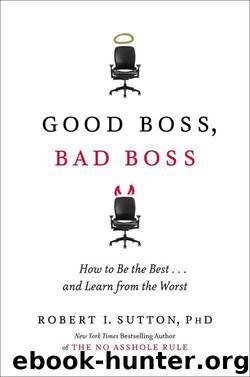Good Boss, Bad Boss by Sutton Robert I

Author:Sutton, Robert I. [Sutton, Robert I.]
Language: eng
Format: mobi
Publisher: Business Plus
Published: 2010-09-06T22:00:00+00:00
STEPPING STONES FOR CAN-DO BOSSES
Tips and Tricks for Eradicating Impediments to Action
1. When your people suggest a promising idea, say (as often as possible): “Great! Do it!” This is inspired by a UPS commercial, where two slick consultants propose cost-cutting ideas to a receptive client. He replies: “Great! Do it!” The consultants look bewildered and respond, “Sir, we don’t actually do what we propose. We just propose it.” In contrast, the best bosses and followers do what they propose.
2. Assign your worst smart talkers to shadow your best doers. Reward both parties if the smart talkers become more action oriented.
3. Fire or demote incurable smart talkers—and let your people know why you did it. Beware of creating a climate of fear, so give people feedback and warnings first. But if you let these rotten apples stick around, they will infect others and produce vile consequences for all.
4. Say the same simple and good things again and again until the message shapes what people do. You might start by borrowing the “ Sesame Street Simple” philosophy from A. G. Lafley.
5. Tell juicy stories about destructive things to stop doing—and simple things to start. One manager often tells a story about his past bad behavior on conference calls. When he wasn’t talking, he tuned out the conversation and answered e-mails. He kept missing important things (like the time a key employee quit), and his direct reports concluded such detachment meant he didn’t care about them or their work. Now he turns off his monitor during calls and imagines his people are in the room.
6. When in doubt, throw it out or don’t add it in the first place. Follow Steve Jobs and try to explain to one another—and customers—the differences among your products and services. If you can’t do so easily, perhaps it is time to get rid of a bunch.
7. Fight the Otis Redding Problem. List all the performance metrics you use. No matter how long it is, pick the three most important. Do you really need the rest?
8. Ask yourself—and your people—if you have practices that “everyone else” uses, but are a waste of time or downright destructive. What about your performance evaluations? People who give and receive them usually hate the process. They are usually done so badly that they do more harm than good. Would you be better off not doing them at all—or at least cutting 75 percent of the questions on your form?
9. Link hot emotions to cool actions. Crank up your people’s fears and hopes to get their juices flowing, then direct that energy to effective and concrete behaviors. Like the financial services executives who kept talking about the need to get more young customers. They got really worked up about it when they recruited twenty-something customers to try their services, which resulted in horror stories about insensitive employees and incomprehensible marketing materials. The executives were then properly inspired to develop practices to chip away at the problem.
* I thank Polly LaBarre for introducing me to this phrase.
Download
This site does not store any files on its server. We only index and link to content provided by other sites. Please contact the content providers to delete copyright contents if any and email us, we'll remove relevant links or contents immediately.
Hit Refresh by Satya Nadella(9085)
The Compound Effect by Darren Hardy(8873)
Change Your Questions, Change Your Life by Marilee Adams(7690)
Nudge - Improving Decisions about Health, Wealth, and Happiness by Thaler Sunstein(7662)
The Black Swan by Nassim Nicholas Taleb(7064)
Deep Work by Cal Newport(6970)
Rich Dad Poor Dad by Robert T. Kiyosaki(6517)
Daring Greatly by Brene Brown(6477)
Principles: Life and Work by Ray Dalio(6299)
Playing to Win_ How Strategy Really Works by A.G. Lafley & Roger L. Martin(6092)
Man-made Catastrophes and Risk Information Concealment by Dmitry Chernov & Didier Sornette(5958)
Digital Minimalism by Cal Newport;(5707)
Big Magic: Creative Living Beyond Fear by Elizabeth Gilbert(5681)
The Myth of the Strong Leader by Archie Brown(5463)
The Slight Edge by Jeff Olson(5380)
Discipline Equals Freedom by Jocko Willink(5337)
The Motivation Myth by Jeff Haden(5176)
The Laws of Human Nature by Robert Greene(5087)
Stone's Rules by Roger Stone(5055)
